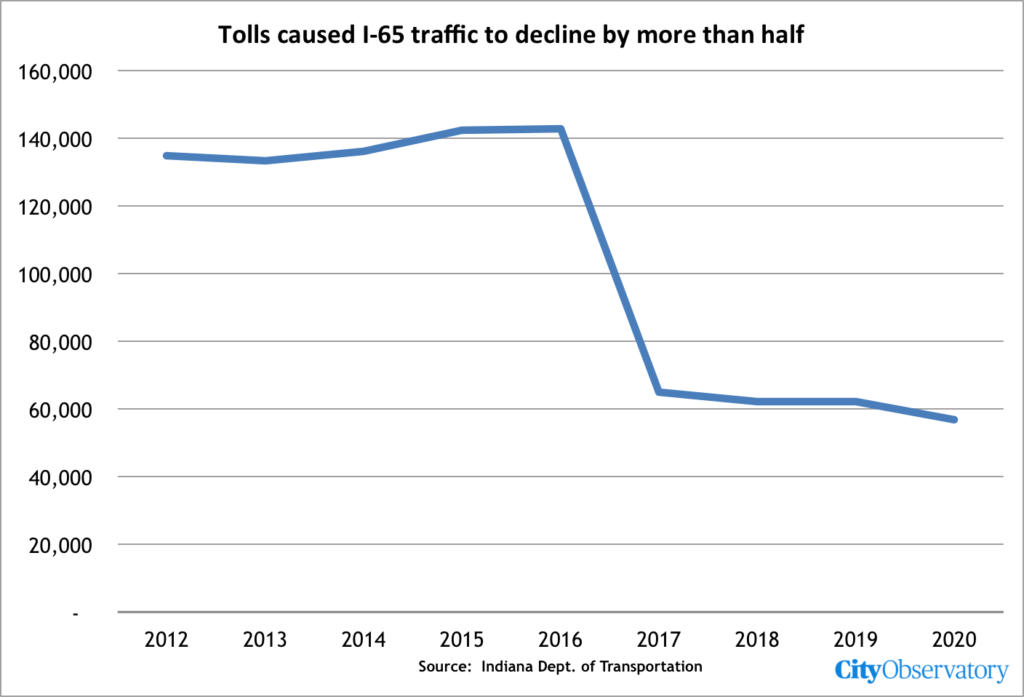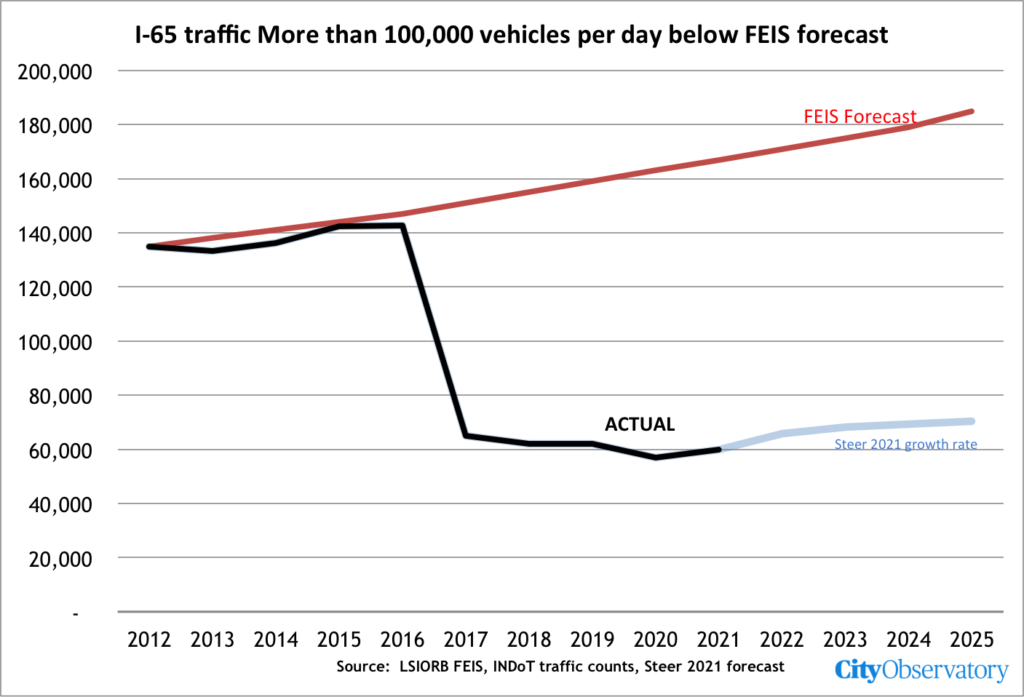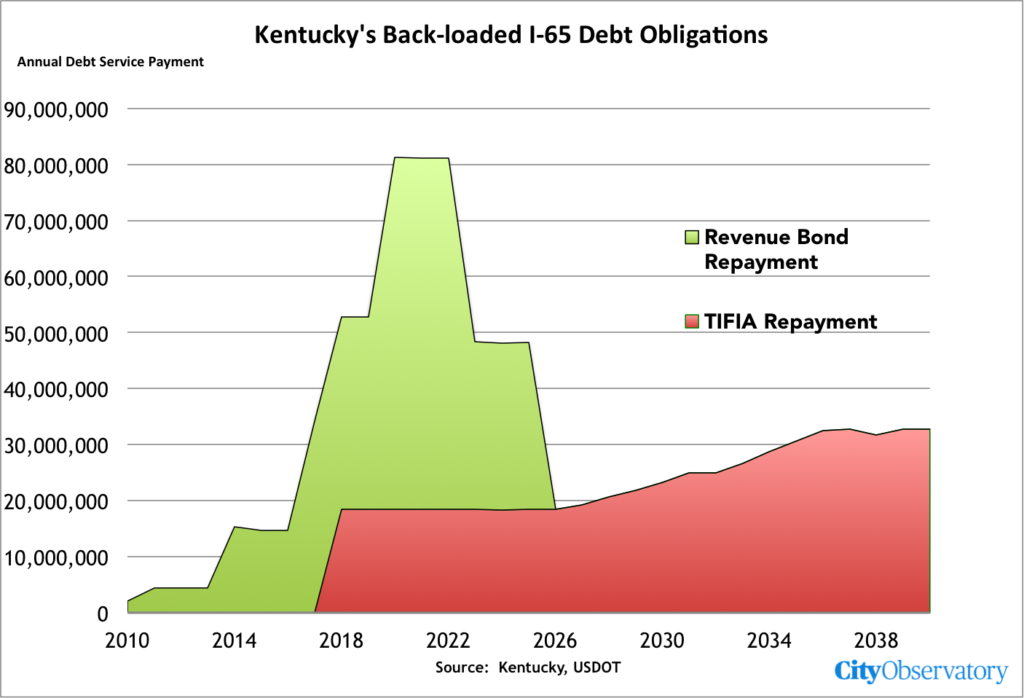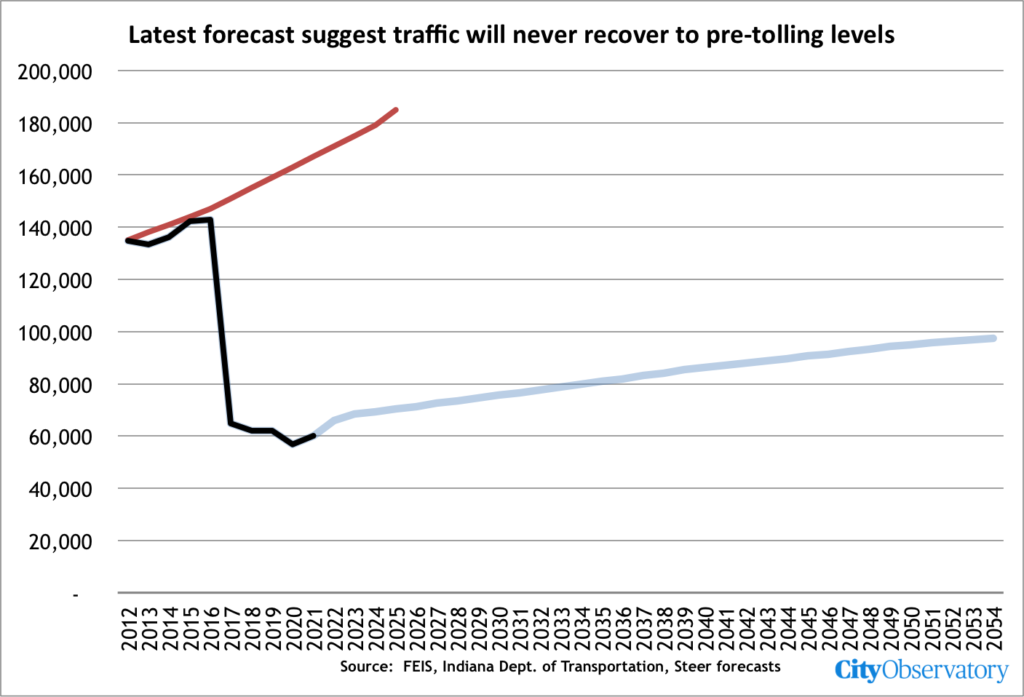Louisville’s I-65 bridges: A huge under-used roadway and hundreds of millions in debt for their kids—who will also have to cope with a climate crisis.
Their financial plan kicked the can down the road, saddling future generations with the cost of paying for unneeded roads.
The two states mortgaged future federal grant money and borrowed against toll revenues, which are falling dramatically short of projections.
Louisville’s Ohio River Bridges are a monument to the epic policy, financial and generational failure that is the US highway system. Ohio and Indiana spent more than a billion dollars on doubling an interstate highway bridge, that thanks to very modest tolls, is utilized at less one-fourth of its capacity. Meanwhile, through a series of “creative” financial maneuvers, it passed the bill for the highway onto future generations, who, as it turns out will have to actually pay for the bridge at the same time the climate crisis hits in full force. The almost empty freeway bridges show the folly of “asphalt socialism”—wasting vast amount of public resources on roads that their users don’t value enough to pay even a fraction of their cost.
Earlier, we wrote about one aspect of the I-65 bridge project in Louisville. It turns out that just by charging a $1 to $2 toll, Kentucky and Indiana were able to entirely eliminate traffic congestion on I-65. Traffic plummeted from around 130,000 vehicles per day to about 60,000. Now, even at the rush hour, I-65 is almost empty.

And after the tolls went into effect, traffic on I-65 fell by half. Here’s the average daily traffic count on I-65, according to data tabulated by the Indiana Department of Transportation. In the years just prior to the tolling, traffic was in the 135,000 to 140,000 vehicles per day level. But as soon as tolling went into effect, traffic dropped to barely 60,000 vehicles per day (with a very slight further decline due to Covid-19 in 2020).
While there’s a hopeful lesson here—one that highway engineers are studiously avoiding—that road pricing can eliminate congestion, there’s a financial horror story that should be a warning to everyone thinking about highway expansion projects. The two states spent over a billion dollars on doubling bridge capacity in downtown Louisville, and their financial plans show how through combination of cynicism, incompetence or saddled future generations with the cost of this boondoggle.
Ostensibly, the justification for widening the bridges was the notion that traffic was already too congested and was growing rapidly. The project’s environmental impact statement claimed that the I-65 bridges were “over capacity” in 2012, and predicted that traffic would grow from 120,000 vehicles per day to more than 180,000 by 2025, leading to hours and hours of traffic delay.
The trouble with these forecasts is that they were both simple-minded and wrong, especially given the need to pay for this project—in part—by actually charging the users for a portion of its construction cost. Like so many state highway department predictions, this one was flat out wrong—traffic was nearly flat-lining on I-65 before the project was built.
State DOT traffic forecasts were wrong
Surely, you must be thinking, the state DOTs knew that charging a toll would reduce traffic. Before the project was completed, Kentucky and Indiana hired consultants—CDM Smith and Steer, Gleaves, Davie—to estimate future toll revenues from the project. CDM Smith predicted that future traffic levels on newly expanded and tolled I-65 bridges would be 92,000 vehicles per day in 2020, growing to 102,600 in 2030.. That was a dramatic over-estimate. Actual traffic levels in 2019 (i.e. the year prior to the pandemic) were just 62,000 vehicles per day. Whereas CDM Smith predicted that tolling would produce about a 27 percent decline in traffic from pre-tolling levels, the imposition of tolls actually led to a 50 percent decline in traffic. CDM Smith overestimated the amount of toll-paying traffic that would cross the I-65 bridge by 50 percent. The direction and magnitude of that error is all too common in toll traffic forecasts, and has led to defaults and bankruptcies for other tolled projects.
Creative Finance: Sending the bills to future generations.
Tolls are only paying for a small fraction of the costs of the project. Both states borrowed substantial sums. Kentucky borrowed deeply to pay for its share of the project, using “Garvee” bonds—essentially mortgaging future federal grant money—to the tune of $300 million in principal repayment and $138 million in interest payments. In addition, Kentucky’s tolls are pledged to pay of both Kentucky revenue bonds of $272 million and a Federal TIFIA loan of $452 million. The debt service for these two borrowings is back-loaded, i.e. is very low in the first few years of the project, but then steadily escalates.
This back-loading means the financial plan for the I-65 bridges project essentially sends the bill to the region’s future residents. Essentially, Kentucky has borrowed most of the money to construction the project and arranged for a loan with a series of “balloon payments,” in later years. Kentucky “back-loaded” the repayment of principal on both its own revenue bonds and its borrowings from the federal government’s TIFIA program. It pays interest-only or just a token amount of the principal for these loans in the first few years, and then required payments steadily escalate in later years. Debt-service obligations start at less than $10 million per year, and then balloon to more than $80 million annually in the early 2020s.
In theory, the escalating repayment can be met by growing toll revenues, from some combination of toll rate increases and growing traffic. Toll rates have increased steadily at 2.5 percent per year, but as the traffic counts show, volume has flat-lined. The artificially low repayments in the first few years of the project create the illusion that toll revenues are sufficient to cover debt service payments, but as required payments steadily escalate over the next few years, the Kentucky will find it increasingly difficult to meet its repayment obligations.
This looming mountain of debt service obligations has already prompted Kentucky to refinance part of its debt, essentially kicking the can further down the road for repayment of the cost of the I-65 bridges. The refinancing plan essentially doubles down on earlier back-loading strategy, borrowing more money now to make these payments, and extending the period for repayment further. Instead of paying off its “first tier revenue bonds” in 2045, they’re extending the term of the repayment by 8 years, to 2053. And like the initial borrowing, these refunding bonds are mostly “interest-only” for the next 25 years, with nearly all of the principal being repaid after 2045. As a result, the borrowers will pay almost as much in interest charges ($182 million over the life of the loan) as they pay in principal ($192 million).
Traffic on I-65 will never get back to pre-tolling levels
Whether toll revenues will be sufficient to repay these bonds hinges on whether you believe the latest forecast from Kentucky’s consultant, Steer & Company, prepared as part of the latest re-financing plan. This new forecast now predicts that total annual transactions (the number of vehicles using the project) will increase from about 30 million today to about 48 million by 2053. What this means is that the I-65 bridges will effectively never recover to the level of traffic they had before the crossing was widened. Currently, as noted above, the bridges are carrying about 60,000 vehicles per day. The latest Steer forecast is that traffic will increase from that level by about 60 percent over the next three decades (48 million = 1.6 x 30 million). This means that in 2053, the bridges will be carrying about 96,000 vehicles (which, ironically, is about the same level that the other toll consultants, CDM Smith predicted for 2020 in the projections that were originally used to justify project financing). On the following chart, the red line is the FEIS traffic forecast for I-65, the black line is the actual level of traffic according to INDOT, and the blue line is the growth in traffic forecast by Steer & Company for the refinancing plan).
Comparing these new refinancing estimates with the rosy projections used to justify the project in the first place show the profound gap between highway boosters and reality. The project was sold based on an environmental impact statement forecast that in the “no action” scenario (with just the single six-lane Kennedy Bridge), traffic on I-65 across the Ohio River would grow to 178,600 vehicles per day, exceeding its “capacity” by 142 percent. This estimate implies that the capacity of the 6 lane Kennedy Bridge was 125,000 vehicles per day. (As traffic expert Norm Marshall has shown these “over-capacity” estimates amount to forecasting the impossible, but neatly serve the interests of highway advocates).
Doubling the size of the I-65 crossing was needed, according to the project’s supplemental EIS in order to assure that the project could carry about 185,000 vehicles per day when completed:
Specifically, the combination of new bridges in the Downtown and Far East corridors would result in the Kennedy Bridge operating at 74 percent of capacity in 2025.
With a capacity of 250,000 vehicles per day (double the 6-lane Kennedy Bridge), the 74 percent of capacity implies a forecast level of travel of 185,000 vehicles per day in 2025. Now, based on the impact of tolling, it’s doubtful that the bridges will ever carry more than a third of their designed capacity, and the much lower level of traffic on I-65 predicted for the 2050s shows that the project was a colossal blunder, wasting a billion dollars. It’s a blunder that future Louisville area residents will be paying for—for decades to come.





